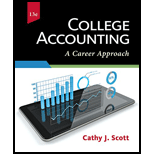
Concept explainers
Journalize the difference between cash count and cash reported on cash register.
Explanation of Solution
Debit and credit rules:
- Debit an increase in asset account, increase in expense account, decrease in liability account, and decrease in
stockholders’ equity accounts. - Credit decrease in asset account, increase in revenue account, increase in liability account, and increase in stockholders’ equity accounts.
Journalize the difference between cash count and cash reported on cash register.
Transaction on April 1:
| Date | Account Titles and Explanations | Post. Ref. | Debit ($) | Credit ($) | ||
| April | 1 | Cash | 385.50 | |||
| Cash Short and Over | 1.25 | |||||
| Income from Services | 386.75 | |||||
| (Record cash shortage in the revenue earned) | ||||||
Table (1)
Description:
- Cash is asset account. Since the cash collected from sales revenue is recorded, the asset value increased. So, debit the cash account with $385.50.
- Cash Short and Over is an income statement (expense or revenue) account. The increase (overage) is credited and recorded as Revenue, and decrease (shortage) is debited and recorded as Expense. Hence, debit Cash Short and Over account with $1.25 indicating an expense.
- Income from Services is a revenue account. Revenues increase the stockholders’ equity value. So, credit Income from Services account with $386.75, indicating an increase in stockholders’ equity.
Working Note:
Compute the cash short and over amount.
Transaction on April 2:
| Date | Account Titles and Explanations | Post. Ref. | Debit ($) | Credit ($) | ||
| April | 2 | Cash | 585.75 | |||
| Income from Services | 582.65 | |||||
| Cash Short and Over | 3.10 | |||||
| (Record cash overage in the revenue earned) | ||||||
Table (2)
Description:
- Cash is asset account. Since the cash collected from sales revenue is recorded, the asset value increased. So, debit the cash account with $585.75.
- Cash Short and Over is an income statement (expense or revenue) account. The increase (overage) is credited and recorded as Revenue, and decrease (shortage) is debited and recorded as Expense. Hence, credit Cash Short and Over account with $3.10 indicating revenue.
- Income from Services is a revenue account. Revenues increase the stockholders’ equity value. So, credit Income from Services account with $582.65, indicating an increase in stockholders’ equity.
Working Note:
Compute the cash short and over amount.
Transaction on April 3:
| Date | Account Titles and Explanations | Post. Ref. | Debit ($) | Credit ($) | ||
| April | 3 | Cash | 585.75 | |||
| Cash Short and Over | 0.90 | |||||
| Income from Services | 586.65 | |||||
| (Record cash shortage in the revenue earned) | ||||||
Table (1)
Description:
- Cash is asset account. Since the cash collected from sales revenue is recorded, the asset value increased. So, debit the cash account with $585.75.
- Cash short and over is an income statement (expense or revenue) account. The increase (overage) is credited and recorded as Revenue, and decrease (shortage) is debited and recorded as Expense. Hence, debit Cash Short and Over account with $0.90 indicating an expense.
- Income from Services is a revenue account. Revenues increase the stockholders’ equity value. So, credit Income from Services account with $586.65, indicating an increase in stockholders’ equity.
Working Note 1:
Compute the cash short and over amount.
Transaction on April 4:
| Date | Account Titles and Explanations | Post. Ref. | Debit ($) | Credit ($) | ||
| April | 4 | Cash | 626.15 | |||
| Income from Services | 623.25 | |||||
| Cash Short and Over | 2.90 | |||||
| (Record cash overage in the revenue earned) | ||||||
Description:
- Cash is asset account. Since the cash collected from sales revenue is recorded, the asset value increased. So, debit the cash account with $626.15.
- Cash Short and Over is an income statement (expense or revenue) account. The increase (overage) is credited and recorded as Revenue, and decrease (shortage) is debited and recorded as Expense. Hence, credit Cash Short and Over account with $2.90 indicating revenue.
- Income from Services is a revenue account. Revenues increase the stockholders’ equity value. So, credit Income from Services account with $623.25, indicating an increase in stockholders’ equity.
Working Note:
Compute the cash short and over amount.
Want to see more full solutions like this?
Chapter 6 Solutions
College Accounting (Book Only): A Career Approach
- i am also posting you can answer my question also you answered my question can i give unhelpful?? You are posting questions and giving unhelpful i am also positing you can give my answer i will not give unhelpful but If you unhelpful my answer then I will unhelpful your answer. Also you know unhelpful will remove after coureshero review. So coperate.arrow_forwardPlease given correct answer for General accounting question I need step by step explanationarrow_forwardCan you explain the process for solving this financial accounting question accurately?arrow_forward
 College Accounting (Book Only): A Career ApproachAccountingISBN:9781337280570Author:Scott, Cathy J.Publisher:South-Western College PubPrinciples of Accounting Volume 1AccountingISBN:9781947172685Author:OpenStaxPublisher:OpenStax College
College Accounting (Book Only): A Career ApproachAccountingISBN:9781337280570Author:Scott, Cathy J.Publisher:South-Western College PubPrinciples of Accounting Volume 1AccountingISBN:9781947172685Author:OpenStaxPublisher:OpenStax College Excel Applications for Accounting PrinciplesAccountingISBN:9781111581565Author:Gaylord N. SmithPublisher:Cengage Learning
Excel Applications for Accounting PrinciplesAccountingISBN:9781111581565Author:Gaylord N. SmithPublisher:Cengage Learning College Accounting, Chapters 1-27AccountingISBN:9781337794756Author:HEINTZ, James A.Publisher:Cengage Learning,
College Accounting, Chapters 1-27AccountingISBN:9781337794756Author:HEINTZ, James A.Publisher:Cengage Learning, Survey of Accounting (Accounting I)AccountingISBN:9781305961883Author:Carl WarrenPublisher:Cengage LearningCentury 21 Accounting Multicolumn JournalAccountingISBN:9781337679503Author:GilbertsonPublisher:Cengage
Survey of Accounting (Accounting I)AccountingISBN:9781305961883Author:Carl WarrenPublisher:Cengage LearningCentury 21 Accounting Multicolumn JournalAccountingISBN:9781337679503Author:GilbertsonPublisher:Cengage





